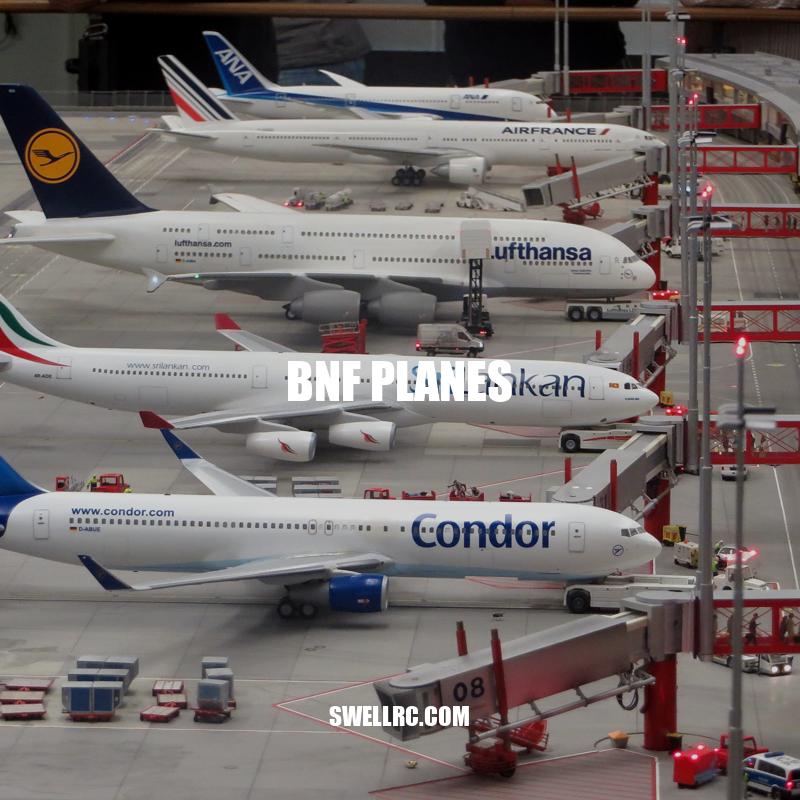BNF Planes: A Beginner’s Guide to Bind-N-Fly Aircraft
BNF planes have become a popular choice for remote control aircraft enthusiasts due to their ease of use and convenience. Bind-N-Fly (BNF) technology is a recent innovation in the remote control aircraft market that enables RC pilots to fly their aircraft with ease and without the need of complicated setup processes. Unlike other remote control aircraft, BNF planes come already equipped with all the necessary electronics and pre-programmed to operate with a transmitter. This means that the only thing required before flying your BNF airplane is the binding process, which could be as simple as pressing a button on your transmitter. In this article, we will explore the world of BNF planes, discuss their benefits, explore how they work, and provide tips for anyone interested in flying a BNF plane.
What are BNF planes?
BNF planes are a type of remote control aircraft that come fully equipped with electronic components, making them easy to set up and fly. Here are some key features and benefits of BNF planes:
- BNF planes come with all the necessary electronic components pre-installed, including the receiver, servos, and speed controller.
- They are pre-programmed to operate with a specific transmitter, which gives the user a “plug and play” experience.
- BNF planes are available in a variety of models, including airplanes, helicopters, and quadcopters.
- They are easy to control and are suitable for beginners.
- BNF planes are often cheaper than other remote control aircraft options, as they don’t require the purchase of as many components.
If you’re interested in purchasing a BNF plane, popular brands like Horizon Hobby, E-Flite, and HobbyZone offer a wide range of models. It’s important to do some research before making a purchase to ensure you are getting the right model for your needs. Online retailers like Amazon and websites like RC Groups and RC Universe offer plenty of information and reviews of different BNF planes to help you make an informed decision.
What is the difference between RTF and BNF RC planes?
RTF (Ready-to-Fly) and BNF (Bind-and-Fly) are two different types of RC planes that have notable differences. Some of the major differences between the two types are:
| RTF | BNF |
|---|---|
| Comes complete with everything needed to fly, including a controller. | Requires a separate compatible controller to fly. |
| Suitable for beginners and those new to the hobby. | Requires some knowledge and experience to set up and fly. |
| Generally less customizable and upgradeable. | Offers more flexibility for customization and upgrades. |
| May have limited range or flight time due to included batteries or components. | Can be equipped with a wider range of battery and component options for longer flights. |
When choosing between RTF and BNF RC planes, it’s important to consider your level of experience and what features are important to you. Websites like Horizon Hobby and RC Planet offer a wide selection of both types of planes to choose from, as well as accessories and parts for customization and upgrades.
How do BNF planes work?
BNF planes operate using a technology known as Bind-N-Fly. Here’s a brief overview of how BNF planes work:
- A BNF plane comes with all the necessary electronics pre-installed, including the receiver, servos, and speed controller.
- The user must have a compatible transmitter, which is used to control the plane.
- The user “binds” the transmitter to the receiver on the plane, which allows the two to communicate and operate together.
- Once the transmitter and receiver are bound, the user can control the plane using the transmitter’s joysticks and switches.
- Some BNF planes have additional features, such as built-in gyro stabilizers that help keep the plane steady during flight.
Here’s an example of a popular BNF plane, the E-Flite UMX Turbo Timber:
| Specifications | |
|---|---|
| Wingspan | 28.15 in (715mm) |
| Length | 21.65 in (550mm) |
| Flying Weight | 2.65 oz (75g) |
| Recommended Battery | 2S 7.4V 200-280mAh LiPo |
| Channels | 4 |
| Control Type | Aileron, Elevator, Rudder, Throttle |
| Price | $129.99 |
It’s important to ensure that your transmitter and receiver are compatible before attempting to bind them together. Most BNF planes come with a receiver that is designed to work with a specific brand of transmitter, so it’s important to do your research before making a purchase. You can find more information on compatible transmitters and receivers on the websites of popular brands like Horizon Hobby and E-Flite.
What is the difference between PNP and BNF RC planes?
PNP and BNF are two types of RC planes that differ in their level of assembly and required equipment. PNP stands for “Plug-N-Play,” while BNF stands for “Bind-N-Fly.” The key differences between the two are:
PNP RC planes:
– Requires a transmitter and receiver to be purchased separately
– Comes partially assembled, usually requiring the installation of the motor, ESC, and servos
– Usually less expensive than BNF planes
– Suitable for those who want more control over their equipment and prefer to customize their planes
BNF RC planes:
– Comes fully assembled and only requires binding with a compatible transmitter to fly
– Usually more expensive than PNP planes
– Suitable for those who want a hassle-free set up and are less experienced with RC planes
Overall, the choice between PNP and BNF planes depends on individual preferences and expertise. For more information on RC planes and other related products, visit websites such as horizonhobby.com or rcplanet.com.
Benefits of using BNF planes
There are many advantages to owning and flying BNF planes, including:
- Convenience: BNF planes come with all the necessary electronics pre-installed, making them easy to set up and get flying.
- Compatibility: BNF planes are designed to be compatible with specific transmitters, so you can be sure that your equipment will work together seamlessly.
- Flexibility: BNF planes come in a variety of sizes and styles, so there’s something for every skill level and flying preference.
- Cost: While some BNF planes can be pricey, they are generally more cost-effective than building a plane from scratch or buying all the individual components separately.
- Quality: BNF planes are typically made with high-quality materials and construction, ensuring that they are durable and can withstand crashes and other mishaps.
Some popular BNF planes on the market today include the following:
| Model | Price | Features |
|---|---|---|
| Horizon Hobby Delta Ray One | $159.99 | SAFE technology for beginner pilots, durable EPO foam construction, optional FPV camera module |
| E-Flite UMX Turbo Timber | $129.99 | Realistic STOL (short takeoff and landing) capabilities, AS3X technology for stability, optional floats for water takeoff and landing |
| Flite Test Mighty Mini Mustang | $89.99 | Easy assembly with laser-cut foam board components, customizable paint scheme, compatible with a variety of power systems |
Whether you are a beginner or an experienced RC aircraft enthusiast, there is a BNF plane out there that is right for you. Check out the websites of Horizon Hobby, E-Flite, and other popular brands to browse their selection of ready-to-fly and bind-n-fly planes.
What does BNF mean in RC planes?
BNF stands for Bind-N-Fly in RC planes. It refers to a type of model aircraft that is pre-assembled and only requires a compatible transmitter to be bound to it before it can fly. BNF models are popular among hobbyists who prefer to avoid the hassle of building their own aircraft from scratch. BNF models often come with a range of features such as stabilizers and various control modes to help beginners get started with flying.
For more information on BNF models, you can check out the website of RC plane manufacturers such as Horizon Hobby or browse online marketplaces like Amazon or eBay where a wide range of BNF models are available for purchase.
Factors to consider when buying a BNF plane
Before purchasing a BNF plane, there are several factors to consider:
- Size: Make sure the plane is an appropriate size for your skill level and the flying area where you plan to operate it. Larger planes can be more difficult to fly and require more space.
- Battery life: The flight time of a BNF plane will depend on the size of the battery and the power demands of the aircraft. Consider how long you want to fly for and make sure the battery life meets your needs.
- Price: BNF planes can range in price from less than $100 to several hundred dollars. Consider your budget and choose a plane that fits within your price range.
- Flying style: Different planes are designed for different flying styles, such as aerobatics, racing, or FPV (first-person view) flying. Choose a plane that aligns with your flying style preferences.
- Brand reputation: Look for BNF planes from reputable brands with a history of producing high-quality RC aircraft.
When shopping for BNF planes online, it’s a good idea to read reviews and watch video demonstrations to get an idea of the plane’s flying characteristics and build quality. Some popular websites for purchasing BNF planes include:
- Horizon Hobby
- HobbyZone
- E-Flite
- Motion RC
By considering the factors listed above and doing your research before making a purchase, you can find a BNF plane that is sure to provide hours of enjoyable flight time.
What does BNF stand for in planes?
BNF stands for Bind-N-Fly. In the context of planes, it refers to the type of remote-controlled aircraft that come pre-assembled, but require a separate controller to operate. Bind-N-Fly planes are a popular choice for RC enthusiasts who prefer to customize their planes with their controllers, rather than using the manufacturer’s proprietary equipment. Some popular websites where you can buy BNF planes include Horizon Hobby and Amazon.
Tips for flying a BNF plane
Flying a BNF plane can be a thrilling experience, but it’s important to follow some basic guidelines to ensure a safe and enjoyable flight. Here are some tips to keep in mind:
- Start with a trainer: If you’re new to RC flying, it’s a good idea to start with a trainer plane. These planes are designed to be stable and easy to fly, making them a great choice for beginners.
- Practice on a simulator: RC flight simulators allow you to practice flying in a virtual environment without risking damage to your plane. This can be a great way to improve your skills before flying your BNF plane.
- Choose a suitable flying area: Make sure you have a large, open space free of obstacles to fly your BNF plane in. Avoid flying near people, buildings, or power lines.
- Stay within the operating range: BNF planes have a limited range of operation, so it’s important to stay within the recommended range to avoid losing control of the plane.
- Check the weather: Windy conditions can make flying a BNF plane difficult, so it’s best to wait for calm weather before taking flight.
- Inspect your plane before flying: Before taking off, check your BNF plane for any damage or loose parts. Make sure the battery is fully charged and secure.
- Take it slow: Begin with slow, gentle movements and give yourself time to adjust to the controls. As you become more comfortable, you can gradually increase the complexity of your maneuvers.
For those looking to improve their flying skills, there are numerous resources available. Many RC aircraft forums have sections dedicated to flying tips and tricks, and there are also instructional videos available on YouTube. Some popular websites for purchasing RC flight simulators include:
- RealFlight
- Phoenix R/C Pro Simulator
- AeroFly RC 7
By following these tips and taking advantage of available resources, you can enjoy safe and successful flights with your BNF plane.
Is it hard to Fly a RC plane?
Flying an RC plane can be difficult for beginners, but with practice and the right equipment, it can be a fun and rewarding hobby. Here are some factors to consider:
– Skill level: RC planes come in different skill levels, ranging from beginner to expert. For beginners, it’s best to start with a basic model that is easy to fly and control.
– Equipment: Choosing the right equipment is essential for a successful flight. A good radio transmitter, receiver, battery and motor are key components that should be chosen carefully.
– Weather conditions: Wind and other weather conditions can affect the flight of an RC plane. It’s important to choose the right weather conditions for the plane and to stay away from obstacles such as trees and buildings.
– Learning resources: There are many online resources available to help beginners learn how to fly RC planes. Websites like rcgroups.com and flitetest.com offer tutorials, forums and reviews of different models and equipment.
Overall, flying an RC plane requires patience, practice and the right equipment. With dedication and a love for the hobby, anyone can learn how to fly an RC plane.
Conclusion
Overall, BNF planes offer a convenient and beginner-friendly option for those interested in RC aircraft. With their easy-to-use technology and wide range of available models, BNF planes have become increasingly popular in the RC aircraft community. By considering the factors discussed in this article, such as size, battery life, and price, you can choose the perfect BNF plane for your needs.
Once you have your BNF plane, it’s important to follow the tips discussed in this article to ensure a safe and enjoyable flight. Whether you’re a seasoned pro or a first-time flyer, taking the time to practice and prepare will lead to a more successful and rewarding experience.
For those interested in learning more about BNF planes and RC flying techniques, there are countless resources available online. From instructional videos to online forums, there are numerous ways to connect with other RC enthusiasts and find the information you need to take your flying skills to the next level.
In conclusion, BNF planes provide an exciting and accessible entry point into the world of RC aircraft. With their advanced technology and user-friendly design, BNF planes are a great choice for hobbyists of all skill levels looking to explore the exhilarating world of RC flight.



